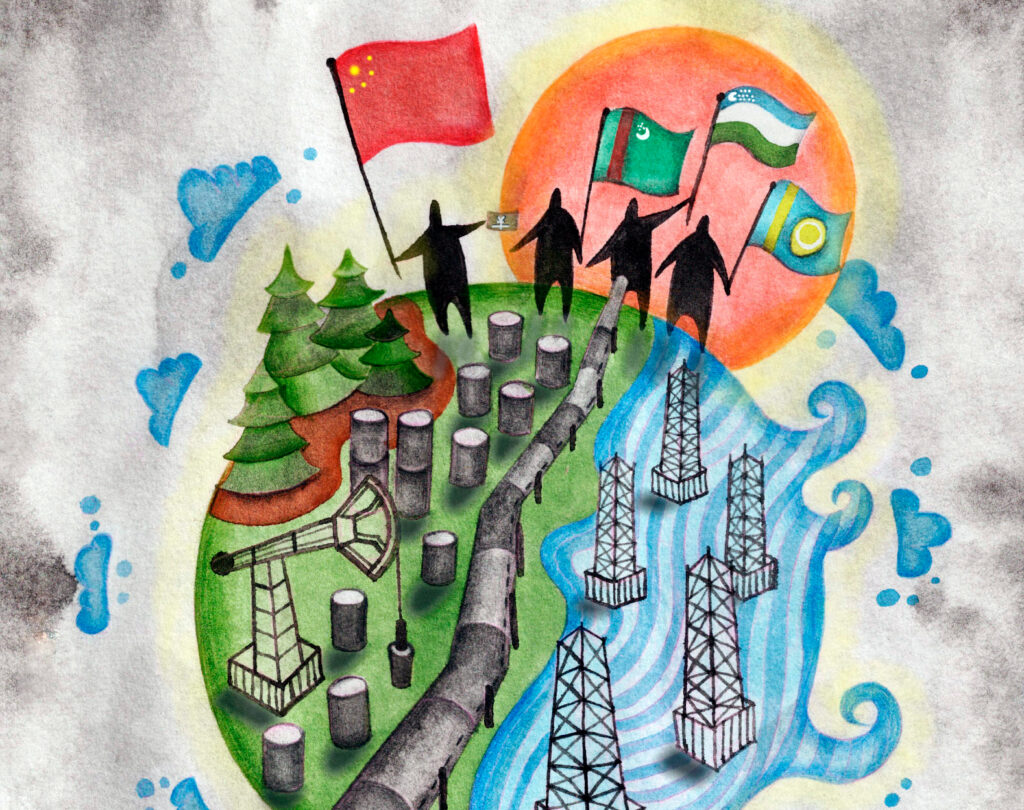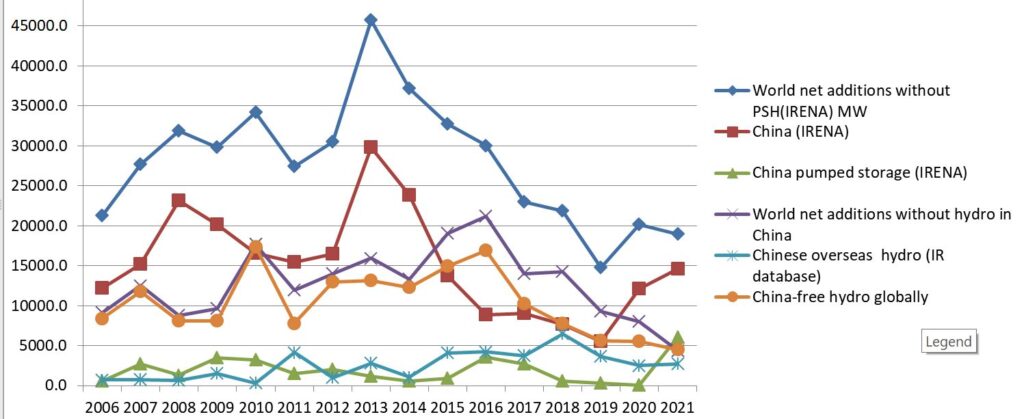
HYDRO-NO LONGER THE ENGINE FOR ENERGY TRANSITION

Source: https://www.irena.org/publications/2022/Apr/Renewable-Capacity-Statistics-2022. Graph by RwB.
In April IRENA issued new Renewable Capacity Statistics: Hydropower net additions (without pumped storage) are preliminarily assessed in 2021 as 18.9 GW, which is only 7% of global growth in renewables estimated as 257 GW (roughly the same additions as in 2022). Hydropower has shown the slowest growth (2%) among all types of renewables (9% an average).
In June the IHA followed with the State of Hydropower Report for 2021 which reveals that 26445 MW were added in 2021, from which 4700MW in pumped storage.

Finally, the Ren21 think-tank also issued its regular report : ”Renewables 2022 Global Status Report”, which has the most informative chapter on hydropower. It estimates expansion of hydropower in 2021 at 26GW and expansion of Pumped storage at 3 GW.
The International Energy Agency recently predicted that in the “main case” (without policy-driven acceleration) hydropower capacity addition will be highest in 2021-2022 (during the period before 2026) and will constitute 33 GW. In If we add to 19 GW of conventional hydro the 4.7GW of pumped-storage hydro (PSH) installed in 2021 then overall addition will be still only 24 GW – one quarter or 9 GW short of the IEA forecast. If we opt to use 26.4 GW reported by the IHA or Ren21, this gap will be 6.6 GW.
Chart on RE capacity additions from the IEA Report Renewables 2021 published in December 21. https://www.iea.org/data-and-statistics/charts/annual-capacity-additions-of-solar-pv-wind-and-other-renewables-main-and-accelerated-cases-2020-2026
Data from all agencies again vividly show that significance of hydropower for energy transition continues to decline, despite hectic efforts of industrial lobby to promote its “decisive role in fighting climate change”. This is fully in line with IPCC report on mitigation issued in April 2022, which listed hydropower as having the least potential to reduce GHG emissions among all measures in energy industry in the period before 2030, when urgent action is needed. See chart: https://www.ipcc.ch/report/ar6/wg3/figures/summary-for-policymakers/figure-spm-7
BAD CLIMATE FOR HYDRO
According to Ren21 Report, despite growth in capacity, “global generation from hydropower fell an estimated 3.5% in 2021 to around 4,218 terawatt-hours (TWh). This reflected changes in hydrological conditions, specifically the significant and sustained droughts that have affected major hydropower producers in the Americas and in many parts of Asia. Loss of glacial icecaps, such as in the Himalayas, is causing long-term change in output in affected areas. The large producers experiencing the greatest decline in generation in 2021 were Turkey (-28.7%), Brazil (-9.1%) and the United States (-8.8%).5 Other major markets with more modest contractions (although in some cases larger multi-year declines) included India (-2.2%), Canada (-1.5%) and China (-1.1%). The IHA Report also referred to similar trend in several regions”.
Increase of river flow may be as dangerous as decrease. Ren21 reminds that “India’s hydroelectricity generation fell slightly during 2021 (-2.2%) to 168.4 TWh, the overall trend in recent years has been a large increase in output, driven mainly by the melting of glacial icecaps.38 In the five years since 2016, hydropower generation rose 31% while installed capacity increased only 9.2%.39 Glacial melting in the Himalayas contributes to increased river flow, as the mountain range has lost an estimated half meter of ice (8 billion tons of water) on average per year over the last two decades.40 In early 2021, the Rishi Ganga River in Uttarakhand swelled more than 15 metres in an avalanche-induced flash flood of glacial meltwater.41 In additions to the many lives lost, the torrent destroyed the 13.2 MW Rishi Ganga plant and damaged the 520 MW Tapovan-Vishnugad plant under construction”.
ACTUAL PICTURE MORE WORRYING THAN IT SEEMS
According to IRENA 46 countries added some hydropower capacity in 2021, while in 9 countries capacity decreased. (Similar numbers observed in 2020 ).The IHA believes that only 38 countries added some capacity. Closer look at IRENA’s statistics shows that actual newly installed conventional hydropower (at country level) accounted for 23 GW (very close to IHA figures), while reported decline in capacity have been almost 4.5 GW, most of it in USA and EU. This mysterious decline is 10 times more than country-level reductions in capacity reported in 2020. This means that despite declining “net additions”, in 2021 we see at least 1.6-3 GW more of new conventional hydro put online than in 2020. Of course, we do not know what part of new capacity comes from modernization of old existing dams, but it normally under 10% and list of countries with new additions makes us think that share is even lower. This, likely, there was year to year increase in new rivers destroyed for hydropower.
PUMPED STORAGE HYDROPOWER (PSH)
PSH is considered a promising way to store energy and regulate energy systems, but its development recently experienced serious setbacks. China has upgraded its policies to incentivize PSH. According to IRENA in 2021 China commissioned 6 GW of pumped storage, which brings overall pumped storage capacity in China to 36GW. According to the IHA China added 4.5 GW, but any project-level evidence is presented only for 1300MW (600 MW at Fengning pumped storage 600 and 700 MW at MW Jilin Dunhua PSHPP). Ren 21 documented 2850MW of new PSH in nine different projects.
Ukraine, who comes next, installed 324 MW of pumped storage.
The United States expanded one PSHPP by 70MW
Poland is listed by IRENA as a country that lost 200 MW of PSH capacity in 2021.
Globally net PSH addition in 2021 was 5992 MW according to IRENA and 4700 MW according to the IHA and we cannot find proof to either of these figures at project level.
An average PSH is less destructive for river ecosystems and sometimes can be built without damming any natural streams (closed-loop design). However, built at wrong place (like Kanev PSH in Ukraine or Snowy-II in Australia) a pumped storage facility may incur as much negative impact as two conventional hydropower plants.
All in all, slowing down of convention hydro development partly depends on incentives created for acquiring costly but reliable PSH technology, which is better suited for regulating energy systems.
THE ROLE OF CHINA
According to IRENA China alone installed domestically 14.5 GW, mostly by completing several megadams in Yangtze Basin, which makes up 80% of net additions in 2021. This includes completion of the first high-altitude dam in Tibetan Plateau-Lianghekou, where it flooded Jinsha river valley – essential refugia both for biodiversity and indigenous people.
According to IHA “China continues to lead the way on new development, contributing 16300 MW of the new capacity that came online in 2021(Besides Pumped storage hydropower totaled 4.5 GW of the new additions in capacity, up on the 1.5 GW added in 2020).
According to Ren21, “While China’s net hydropower capacity grew around 5.6%, generation fell 1.1% to 1,340 TWh in 2021. Hydropower’s relative contribution to the country’s energy mix has declined in recent years as other generating technologies have gained market share and as capacity utilization has decreased (due likely to changing weather patterns). During the (13th five-year plan) period 2016-2021, China’s overall electricity generation rose more than 36%, while hydropower output grew only around 12% (with capacity growth of 16%), causing hydropower’s share of supply to drop from 19.4% to 16%.”
In the rest of the world approximately 6 GW of hydropower was installed in 2021 and no country besides China installed more than 1 GW. Much of those additions came with China’s financing and/or hydroengineering contracts. In our preliminary estimate Chinese companies in 2021 participated in installing at least 2200 MW in other countries of the world. This brings participation of Chinese companies up to 90% of net hydropower capacity installed globally in 2021.
WHAT OTHER COUNTRIES INSTALLED HYDROPOWER IN 2021?
According to the IHA and Ren21 reports, globally installed hydropower in 2021 included at least 11 pumped storage units, completion of units in approximately 25 conventional dam-based large greenfield hydropower projects, more than 80 small hydropower stations (<10MW). Reports named only 6 projects of expansion through modernization of existing facilities, but this is due to less attention paid to this crucial activity by industry and governments. Accuracy of national reporting to IRENA differs from country to country and we rely on IHA\Ren21 data in case of discrepancy. We also found no explanation for exceptionally high figures of decrease in capacity in the United States (3.8 GW) reported by IRENA. Table below covers only capacity additions > 10 MW.
| Country | ALL (MW) | Without PSH | PSH | Project-level data, mostly from IHA, Ren21 and RwB |
| IHA and (Ren21) | IRENA | Ren21 | Projects associated with documented serious env. problems highlighted | |
| China | 20840 | 14500 | 2850 | Conventional HPP:6 units 6000MW of Baihetan,3400MW of Wudonghe, 2500 at high altitude Lianhekou and 1500 at Yangfanggou. Pumped storage: 600 MW of 3600MW Fengning pumped storage,700 MW of the 1400 MW Jilin Dunhua, and 7 other PSH units according to Ren21 |
| Canada | 924 | 1333 | Ren21: the 824 MW Muskrat Falls facility in Labrador brought into service the second half of its generating units during the year. The project suffered significant delays and budget overruns. Difficulties also remain with the transmission interlink with Newfoundland, cutting off intended customers. In Manitoba, the first five of the seven generating units making up the 695 MW Keeyask plant were placed into service in 2021. | |
| India | 803 | 800 | last two 150 MW turbines at the 600 MW Kameng project in Arunachal Pradesh, two 50 MW units at Sorang, 113 MW at Rongnichu and three 60 MW units ready for service by year’s end at the Bajoli Holi HPP | |
| Nepal | 684 | 690 | 450MW Upper Tamakoshi finally commissioned after many years of delay and serious overspending | |
| Laos | 600 | 767 | Part of Nam Ou Cascade project is operational. Power China has 29-year BOT rights to entire Ou River basin. Project is impacting local communities and Luang Prabang World Heritage property | |
| Turkey | 513 | 509 | The remaining two 155 MW turbines were installed at the 500 MW Lower Kaleköy on the Murat River (Upper Euphrates). Also on the Murat River, Turkey’s 280 MW Alpaslan II plant was completed by its Czech developer. Its reservoir is among the ten largest in Turkey. The 58 MW Gürsögüt scheme completed, and over 30 smaller-scale hydropower plants. | |
| Indonesia | 481 | 461 | Last 200 MW at 515 MW Poso River project on Sulawesi, 90 MW Malea plant on the Saddang River in South Sulawesi both by Kalla Group with support from Power China consultants. 18 small hydropower units totalling 111 MW in Sulavesi. | |
| Norway | 396 | 1081 | Most of the 50+ new projects commissioned were small-scale hydro below 10 MW in size, in addition to the 62 MW Jølstra, 42 MW Tolga and 22 MW Herand, and 70 MW came from upgrades | |
| Viet Nam | 222 | 765 | Bach Dang (5.3 MW) and Thuong Kon Tum (220 MW) on Se San River tributary of the Mekong River recognized for its rich aquatic and terrestrial ecosystems | |
| Brazil | 175 | 108 | Ren21: Brazil added 13 generating units totalling 119 MW in 2021 (each less than 10 MW). Hydropower generation dropped sharply from the previous year (down 9.1%) to 378 TWh, comprising 63% of supply.58 In terms of both energy generated and the share of Brazil’s electricity mix, hydropower has been in long-term decline since its peak in 2011 (when it reached 453 TWh and a 91% share) | |
| USA | 172 | 0 | 70 | Ren21: Nine small hydropower units were added with 103 MW in 2021. Bad Creek PSH enlarged by 70MW |
| Russia | 167 | 74 | Continuation of Ust-Srednekanskaya HPP, Modernization of Nizhegorodskaya, Irkutsk, Barsuchkovskaya, and Votkinskaya | |
| Austria | 150 | 0 | 17.5 MW Traunleiten hydropower plant | |
| Zambia | 150 | 150 | Part of 750 MW Kafue Gorge Lower HPP built by Sinohydro | |
| Kazakhstan | 129 | 248 | Only 25 MW at Turgusun Hydro is known to RwB (IHA mistakenly placed Uzbek Zarchob Hydro here) | |
| Argentina | 115 | 1 | Small hydro | |
| Peru | (84) | Ren 21: completed 84 MW La Virgen hydropower plant, after years of delays | ||
| Philippines | 85 | 6 | ?? not supported by project-level data | |
| Uzbekistan | 76 | 38 | Likely correct IHA figure | |
| Tajikistan | 49 | 1 | ?? not supported by project-level data | |
| Costa Rica | 48 | 48 | ?? not supported by project-level data | |
| Chile | (39) | Ren21: brought into service two units, the 24 MW Digua and the 14.9 MW Hidromocho. Hydropower generation fell sharply in 2021 (down 20%) to represent 20% of the country’s electricity supply, well below the 30% average | ||
| South Korea | 35 | 35 | ?? not supported by project-level data | |
| Sri Lanka | 35 | 0 | ?? not supported by project-level data | |
| Ecuador | 31 | 1 | Ren21: the first of three 16.3 MW units of the 49 MW Sarapullo plant, on the Pilatón River | |
| Uganda | 24 | 0 | ?? not supported by project-level data | |
| Spain | 16 | 0 | ?? not supported by project-level data | |
| Honduras | 12 | 12 | ?? not supported by project-level data | |
| Switzerland | 12 | 0 | ?? not supported by project-level data | |
| Georgia | 10 | 116 | IHA figure is more accurate | |
| Ukraine | 0 | 0 | 324 | Part of 1200 MW Dniester River PSH |
| World without PSH | 22293 | 22847 | 3244 | IRENA’s data on 6 GW of new pumped storage, likely, grossly erroneous. But two thirds of the IHA’s claim about 4700 MW not supported by project-level data either. Thus, Ren21 figure is the most reliable. |
| World,China excluded: | 6153 | 8346 | 394 | These figures do not account for IRENA’s records on hydropower capacity decrease in 9 countries, since no available evidence found at project level . |


